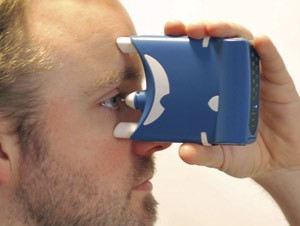A tonometer for home monitoring of intraocular pressure may be a useful aid for some glaucoma patients, but there are also implicit problems.
Many patients with diabetes take their own blood sugar readings. This may add to their own understanding of their illness and result in better patient follow-up. Glaucoma also entails life-long follow-up with the patient consulting an ophthalmologist for intraocular pressure measurement, usually several times a year. There are various tonometers that may lend themselves to home monitoring and more accurate and user-friendly instruments are gradually being developed (1).
A new portable device that can measure eye pressure without the use of topical anaesthetic is now on sale in Norway (2). The manufacturer is Finnish, and the tonometer weighs only 150 grams. The pressure is measured with a thin, magnetised and disposable probe that comes into momentary contact with the cornea (Fig. 1). The instrument then measures how rapidly and with what force the probe rebounds after touching the cornea. If the eye pressure is high, the probe will rebound faster and with greater force than if the pressure is low. The result is shown on a display on the device. All measurements are stored on the device and can be transferred to a computer so that more accurate values and measurement times can be read.

Figure 1 Tonometer for home monitoring in use. Photo: Geir Qvale
A German study has shown that results from this tonometer correlate well with applanation tonometers (3). At present ophthalmologists mainly use applanation tonometers, which estimate pressure by measuring the force required to flatten a particular area of the cornea.
Intraocular pressure and glaucoma
High intraocular pressure is the greatest risk factor for the development and progression of glaucoma with subsequent loss of vision. The only treatment available is to lower the ocular pressure. This can be achieved with the aid of medications, laser treatment or surgery. Poor compliance is common with topical eye medications.
Most people with healthy eyes have an eye pressure in the range 10 – 21 mm Hg. The risk of developing glaucoma rises with increasing pressure. However, there are patients with glaucoma without elevated pressure (low-pressure or normal-pressure glaucoma) as well as people with high pressure without glaucoma damage (ocular hypertension). The pressure in an individual person can vary over a 24-hour period (4).
Patients with narrow-angle glaucoma may benefit from self-tonometry. These patients may experience a rise of pressure in the dark because the chamber angle is occluded when the pupil dilates. These patients can thus measure their pressure easily when they develop symptoms. Many of these patients are relatively young.
Some open-angle types of glaucoma in particular, including pigment glaucoma and pseudo-exfoliation glaucoma, may lend themselves to home monitoring because the intraocular pressure fluctuates. Patients with secondary glaucoma due to uveitis or neovascularisation may also experience a sudden rise in pressure with or without symptoms. Most patients with wide-angle glaucoma are older, however, and have a fairly stable intraocular pressure, which is therefore less suitable for home monitoring. Sometimes these patients may experience an exacerbation of their visual damage despite acceptable pressure readings at the ophthalmologist’s surgery. Home monitoring of pressure may then reveal pressure peaks and encourage compliance.
There are many different pressure-reducing topical medications on the market, and it may be difficult to find the drops that are most effective for the individual patient. Home monitoring may be useful for finding the optimal combination of medications.
Ethical and professional considerations
Achieving correct readings is contingent on correct use of the tonometer. Thorough instruction and individual adaptation of the apparatus are therefore important. Persons with poor sight and impaired manual fine motor skills may have difficulty in using the instrument.
Self-measurement of intraocular pressure holds great appeal for some patients, and some have purchased a tonometer of their own initiative. Many glaucoma patients derive little benefit from self-tonometry, however. Frequent home monitoring may reduce the quality of life for many patients, and a random high pressure reading may create anxiety and unnecessary medical consultation. Nor is the absence of high pressure any guarantee that the disease is not progressing. Optic discs must still be assessed in order to investigate whether there is any progression, and testing of the field of vision must be carried out and interpreted by an ophthalmologist. The tonometer should therefore only be used in collaboration with a doctor.
Conclusion
For some glaucoma patients, home monitoring of intraocular pressure may be a beneficial supplement to consultations with an ophthalmologist. Home monitoring may increase the intervals between visits to the ophthalmologist and can identify patients who develop unexpected high pressure so that treatment can be intensified to prevent glaucoma progression. The effect of treatment can also be monitored. In some cases, self-tonometry can be used to help diagnose glaucoma.
